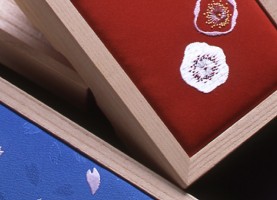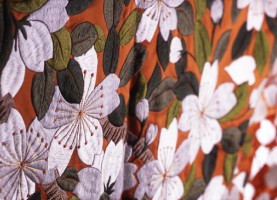

もともと刺 繍 は、仏画を刺 繍 で表現した掛け物である 繍 仏から発展しました。平安建都(794 年)の際、繍 仏をはじめ貴族の 装 束や武具を飾る刺 繍 技術の技術者が組織され、京繍が生まれました。絹や麻の織物に美しい絹糸や豪華な金糸銀糸を使い、花 鳥 風月をモチーフとした図柄は写実的で、絵画のようです。表現方法も多彩で、現在使われているものだけでも 30 種類以上にのぼる繍の技法があります。
Embroidery was originally used to embroider Buddhist images on priests’ garments and alter hangings. When the Heian-kyo capital was established at the site of present-day Kyoto in 794, craftsmen skilled in embroidery were organized to produce various Buddhist garments, as well as decorative goods and clothing for the aristocracy. Beautiful silk thread and real gold and silver thread are used to embroider silk or hemp materials with realistic, picture-like patterns, typically on natural themes. Many different embroidery techniques have been developed, and more than thirty are still in use.
美しい桐箱に添えられた
女性京繍作家による雅やかな技
A beautiful paulownia chest, decorated with graceful embroidery by a Kyoto needleworker.
平安時代から続く京繍を現代の作品に
京繍作家・長艸敏明の工房
Kyoto embroidery – originating in the Heian period – in a modern context. The studio of Toshiaki Nagakusa, a Kyo Nui artist.




